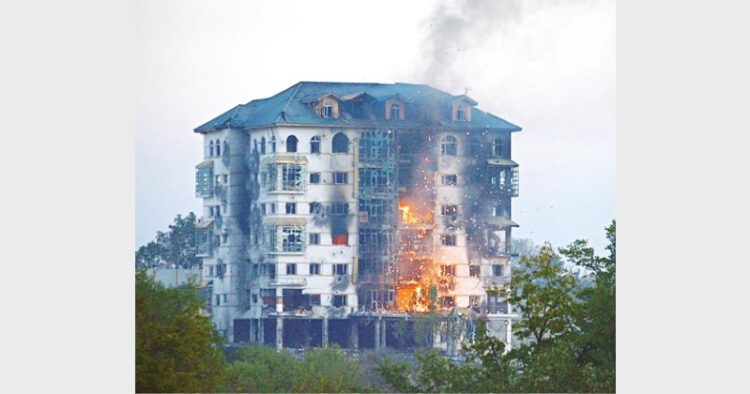Four terror attacks in the year 2016 have exposed that terrorists have changed strategy because their aim is to engaged security forces for longer period and get maximum publicity by inflicting maximum casualties to the security forces
Deepak Zazia from Srinagar
Around 50 hours long fierce encounter between security and terrorists at the Entrepreneurship Development Institute (EDI) building, located at Pampore on the banks of the river Jhelum and 12 km from the Srinagar city centre, which ended on October 12, reminded of the similar terror strike which took place in same building on February 20, 2016. In the February 2016 terror strike, which lasted for 48 hours, inflicted huge casualties to the security forces as three commandos of the Army, including two officers had attained martyrdom in the encounter. But this time security forces moved very cautiously and avoided any casualty.
The gunbattle that started on October 10 morning ended after 48 hours after terrorists barged into EDI building in Pampore area on Srinagar-Jammu National Highway where scores of youth takes training.
Four terror attacks in the year 2016 have exposed that terrorists have changed strategy because their aim is to engage security forces for longer period and get maximum publicity by inflicting maximum casualties to the security forces. The new strategy started when terrorist attacked Air force base at Pathankot in which gun battle lasted for over 80 hours. Second such attack took place at EDI building in Pampore on February this year which also lasted for 48 hours. Poonch encounter which
started on the eve of Eid this year also lasted for over 60 hours. And the gunbattle at EDI building, which started on October 10, also lasted for 48 hours.
The Defence experts have underlined a shift in the strategy of terror groups — Engage security agencies for “longer period” to inflict maximum collateral damage and seek “utmost attention” from the world community. Earlier
during suicidal attacks, terrorists took maximum 24 hours for final assault but now as part of new strategy, terrorists are engaging security forces for longer time to inflict casualties to the security forces.
“A clinical and surgical shift in the strategy of terrorists, including fidayeens, has been reported in the recent times. The suicidal terrorists
generally do not extend encounter for a long period as they come to either kill the people or get killed. Extending the encounters with security forces for longer period is aimed at gathering maximum attention from the world
community besides inflicting maximum collateral damage to the forces,” said a senior police official involved in
counter-terrorism operations.
Instead of felling into the trap of the new strategy of terrorists, security forces this time adopted extra caution to avoid any collateral damage. Security forces have learnt a lesson from previous terror strike in the same building in which three terrorists had kept the security forces engaged for 48 hours at the
multi-storey building attack in Pampore area from February 20 to 22 early this year. The operation was launched on February 20 evening after the terrorists attacked a CRPF convoy on the Srinagar-Jammu national highway and took refuge in the multi-storeyed
complex. Three elite commandos of the Army, including two officers, two CRPF jawans and 13 others were injured in the attack. Since October 10 morning, when the terrorist squad took position inside the building, the security forces fired several hundred 84-mm rockets.
The offensive to kill the terrorists was fierce but slow paced as the security forces ruled out the effective but risky room-to-room intervention. Instead of taking the risk of conducting room to room operation, security forces tried to end the battle with a fierce fury of firepower, without suffering any casualty. An Army officer said the priority was to avoid casualty to the security forces. Time was no consideration.
Security forces are very much aware that the terrorists appeared to have
carefully selected the multi-storeyed building as its concrete structure, which has so far remained resistant to a fierce barrage of rocket fire. Furthermore they wanted to engage security forces for longer time to get maximum attention and inflict more causalties.
The security forces pounded the sprawling building with rocket fire and improvised explosive devices (IED) throughout the second day. “There are reports that at least two militants have been seen moving down the staircase,” the police official said.
“It is difficult for the militants to have survived 100 kg of IED blast detonated last night, but we have to be dead sure that they are dead. Otherwise there is no use of firing so much ammunition,” the official said. On the first day of the encounter, as the security forces approached the building between
intermittent gunbattle, one soldier was injured. As the combing operations reached its final stages on October 12, 52 hours after the attack began, two militants holed up inside the building were killed and their bodies recovered. Number of casualties were minimised also because the building was mostly empty when the militants occupied it, with the hostels and offices largely vacant.
EID attracts youths from across J&K to its programmes on skill development and capacity building. The institute which started functioning in 2004 and trained over 4,000 youths ever since, had its main complex destroyed in February. The first four floors of the hostel building are used as office space after that. Around 50 hours encounter this time, even though most of the parts were blown up the concrete building has been reduced to a skeleton.
On October 10, former J&K Chief Minister and National Conference chief Omar Adbullah mourned the attack on EDI, tweeting, “All the EDI ever did was to train young Kashmiri boys & girls to stand on their own feet & not to seek government jobs. Militants don’t like that!”














Comments